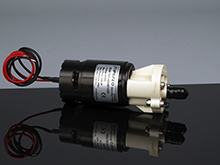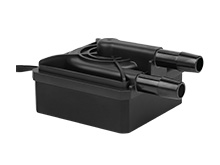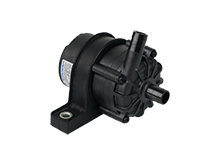An Overview of the Development of Server Cooling Systems
2023-06-05
With the continuous development of computer technology, the scale and density of data centre increasing, and the power and integration of servers increasing, server cooling systems have gone through a development process from non-existent to traditional to new.
Initially, data centers used naturally ventilated, non-air conditioned methods to cool servers, but as power density increased and heat dissipation requirements increased, air cooling began to fail. At this point, liquid cooling technology began to be applied, and gradually developed into a more efficient and reliable method of server cooling. Today, liquid cooling technology has been used in large data centers, becoming the mainstream method of server cooling.
This article will focus on the history of server cooling systems.
1.Learning about Server Cooling Systems
A. What is a Server Cooling System
A server liquid cooling system is a system that circulates coolant through server components to absorb heat and transfer it to cooling equipment. The principle is to transfer and dissipate the heat generated by the server through the liquid coolant, so as to achieve the cooling effect of the server. The server liquid cooling system usually consists of liquid coolers, coolers, liquid cooling pipelines, and liquid cooling pumps etc.

Liquid coolant: Usually with high heat capacity, high heat conductivity, low viscosity, non-toxic and non-flammable liquid, such as water, oil, freon, etc.
Coolers: mainly refer to radiators, water cooling heads, etc. The function of the radiator is to exchange heat between the liquid coolant and the outside air, dissipating heat. The water cooling head mainly transfers the heat from the server components to the radiator through the flow of the liquid coolant.
Liquid cooling pipe: pipe that transfers liquid coolant from liquid cooler to radiator. It is generally made of high strength and corrosion resistant material.
Liquid cooling pump: used to drive the circulation of liquid refrigerant in the liquid cooling pipeline to ensure the heat exchange effect of the radiator. The Server cooling water pump is one of the key components in the liquid cooling system of the server. Its function is to transfer the liquid coolant from the low temperature area to the high temperature area through the rotation of the impeller, forming a circulating flow process. The pump plays the role of bearing pressure and increasing flow in the liquid cooling system, but also has a stable working state and high efficiency, in order to achieve effective cooling effect.
B. Why do you Need Server Cooling Systems
The server equipment will generate a lot of heat when it is running for a long time. If the heat cannot be dissipated in time, the temperature of the equipment will be too high, the working efficiency and life of the equipment will be reduced, and even the equipment will fail. In order to ensure the normal operation of the data center, a proper cooling system must be used to reduce the temperature of the server equipment.
2.Early Server Cooling System
A. 1950s - 1970s: No air conditioning, naturally ventilated cooling system
In the age before the popularization of computers, the heat dissipation problem of data centers was not prominent due to the small number of devices. Most of them used natural ventilation or simple fans for heat dissipation.
B. 1980s: Air conditioning appeared and cabinets began to be used
With the popularization of computers and the increase of the number of equipment, the traditional way of heat dissipation gradually fails, and the data center began to use air conditioning system to control the temperature. At this time, the use of cabinets becomes a common trend, the air flow is more reasonable, and the heat dissipation efficiency is improved.
C. 1990s: Power density increases and air cooling begins to fail
With the continuous improvement of computer performance, the power density of equipment is also higher and higher, the traditional air cooling method has been difficult to meet the demand, seeking a new heat dissipation method has become a key issue in the data center industry. Low heat dissipation efficiency, high power consumption, and high failure rate of servers have also become pain points for the data center industry.
3.New Server Cooling Methods
A. Early 2000s: Liquid cooling technology began to be applied
Liquid cooling technology is attracting more and more attention because of its high efficiency and low energy consumption. The early liquid cooling technology mainly used the advantage of liquid heat transfer to improve the heat dissipation efficiency of the server. In 2003, for example, IBM introduced a server based on water-cooling technology that replaced fans by directing water into radiators.
B. 2010s: liquid cooling technology continues to improve and its application scope gradually expands
With the continuous advancement of technology, the application range of liquid cooling technology continues to expand.
For example, INTEL introduced a technology called "Thermal Zone" in 2012, which improves heat dissipation efficiency and reduces power consumption by directly connecting the heat sink to the chip. In addition, liquid cooling technology is also used in high-performance computing fields such as supercomputers to improve the performance and stability of computers.
In 2014, one of the world's largest data center operators, Google's data center in Finland, used a technology called "All-liquid cooling", which means that all servers are immersed in liquid, thereby heat is transferred to the liquid, which is dissipated by an external heat exchanger.
Microsoft is also using a liquid cooling system called the "Liquid Module" in its data center in Dublin, Ireland, to reduce energy consumption and improve server performance.
The application of liquid cooling technology can not only improve heat dissipation efficiency, but also reduce energy consumption and carbon emissions of data centers. According to statistics, the energy consumption and carbon emissions of data centers using liquid cooling technology can be reduced by more than 40% and 90% respectively. Therefore, liquid cooling technology is considered to be one of the important development directions of future data centers.
4.Future Trends and Prospects
In the future, with the widespread application of emerging technologies such as 5G, artificial intelligence, and cloud computing, data centers will face higher power density and heat dissipation requirements. Therefore, the development of server cooling systems will be even more critical. With the continuous advancement of technology, liquid cooling technology will become more mature and its application range will be wider.
As a company specializing in the manufacture of micro pumps, TOPSFLO High Density Server cooling pump TDC is widely used in the liquid cooling system of the data center. TDC GPU Server cooling pumps can precisely deliver liquid to the equipment that needs to be cooled, thereby improving the efficiency and performance of the system. At the same time, it also has the advantages of small size, low noise, and high reliability, and is very suitable for application in high-density data centers.
In conclusion, server cooling systems are a key part of data centre operation and their continuous development fully reflects the progress of human technology and the spirit of continuous pursuit of efficiency and reliability. In the future, we have reason to believe that server cooling systems will continue to innovate and improve, providing better support for the efficient, reliable and sustainable operation of data centres.










.jpg)


